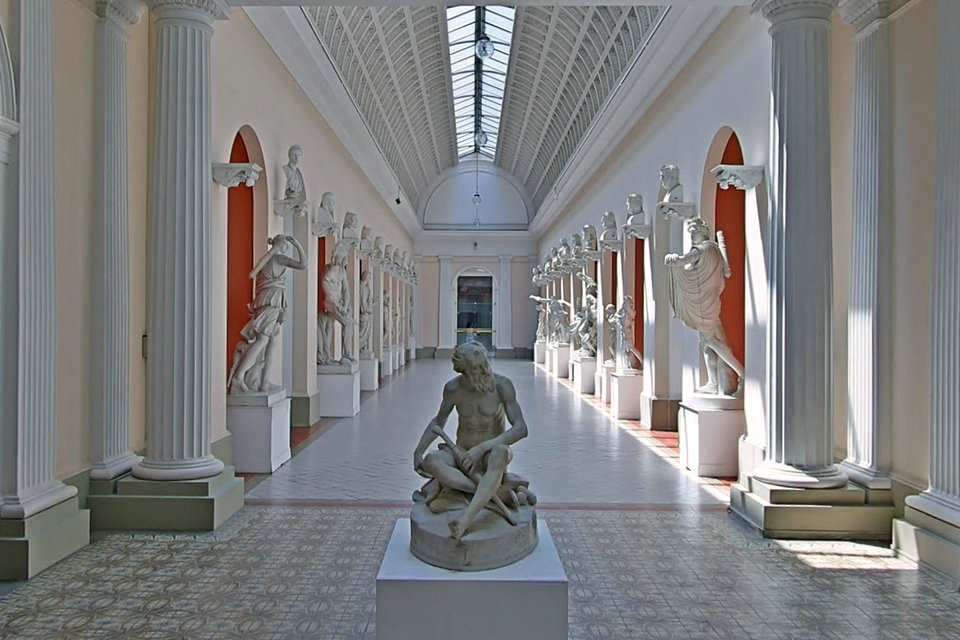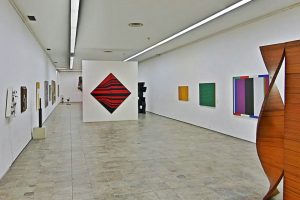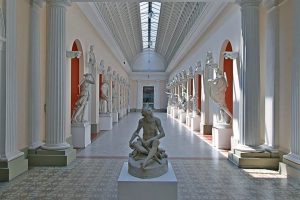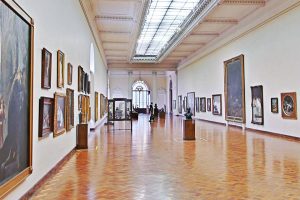One of the postcards of the National Museum of Fine Arts, the two Molding Galleries are home to more than 150 plaster works. This magnificent collection consists of pieces molded on originals from the Hellenistic, Roman, and classical Greek period (the so-called Golden Age). Most of the Moldings exhibited in the two galleries on the 2nd floor of the MNBA are pieces made from the beginning of the 19th century until 1928, mainly in the period between 1860 and 1875, in France.
At the Imperial Academy of Fine Arts, and later at the National School of Fine Arts (ENBA), the study of drawing was done using plaster molds. At that time it was understood that simple contemplation was not enough to understand the beauty of classical sculpture, and drawing was necessary to achieve the noble and grand aspect of the works.
Part of the plaster moldings collection was acquired in order to fill the niches on the second floor of the building, which was built in 1908 to house the National School of Fine Arts.
Plaster moldings were made using the direct molding technique on the original sculptures distributed in the main European museums. Currently, this procedure is not allowed, giving the collection great importance for the historical representation of artistic education in Brazil.
Brazilian Sculpture
Inside the Brazilian section, is a great historical arc starting in the Brazilian colonial period, extending to the present day, having great expressiveness the time of the Brazilian academic art, especially the historical connection of the institution with the Fine Imperial Academy Arts and successively with the National School of Fine Arts and the annual Halls. In this context, we highlight, due to their dimension, the works of Rodolfo Bernardelli, and their representativeness, those that entered the National Salon of Modern Art.
Foreign Sculpture
The foreign section, with some representation of the century. XIX, has its greatest attraction in the plaster collection that allowed students of the Imperial Academy of Fine Arts to be closer to works of international reference. The initial set was purchased from then professor Marc Ferrez, in 1837 and 1846, and increased from 1860 with moldings from the workshop of the Imperial Museums and after the French Nationals. We also highlight the “Antínoo”, original Roman marble in the time of Emperor Hadrian, which was found in 1878 in excavations sponsored by D. Tereza Cristina, Empress of Brazil, in the vicinity of Rome, more precisely in Veio, an ancient Etruscan city.
Brazil National Museum of Fine Arts
The National Museum of Fine Arts (MNBA) is an art museum located in the city of Rio de Janeiro, Brazil. It concentrates the largest collection of works of art of the 19th century, being one of the most important museums of its kind in the country.
Located in the historical center of Rio de Janeiro in an eclectic architecture building designed in 1908 by the architect Adolfo Morales de los Rios to host the National School of Fine Arts, heir of the Imperial Academy of Fine Arts, the National Museum of Fine Arts / Ibram / MinC was built during the urban upgrades carried out by Mayor Pereira Passos in what it was then the Federal Capital of the country.
Created officially in 1937 by the decree of President Getúlio Vargas, it occupies an area of 18,000 m2 and is the most important art museum in the country. It brings together a collection of seventy thousand items among paintings, drawings, engravings, sculptures, objects, documents and books, constituting itself as a radiating center of knowledge and dissemination of Brazilian art.
The museum’s collection began with the set of works of art brought by Dom João VI, in 1808, and was expanded throughout the 19th and early 20th centuries with the incorporation of the National School collection and other acquisitions, and today it has about 15,000 pieces, including paintings, sculptures, drawings and prints by Brazilian and foreign artists, as well as a collection of decorative art, furniture, folk art and a set of pieces of African art.
The bicentennial Collection of the National Museum of Fine Arts originated from three distinct sets of works: the paintings brought by Joaquim Lebreton, head of the French Artistic Mission, who arrived in Rio de Janeiro in 1816; the works belonging to or produced here by members of the Mission, among them Nicolas-Antoine Taunay, Jean-Batiste Debret, Grandjean de Montigny, Charles Pradier and the Ferrez brothers; and the pieces of the Collection D. João VI, left by him in Brazil when returning to Portugal in 1821. These collections have been enriched by important donations and acquisitions, such as the bust of Antínoo, a rare marble archaeological piece donated by the Empress D. Teresa Cristina to the Imperial Academy of Fine Arts in 1880.





